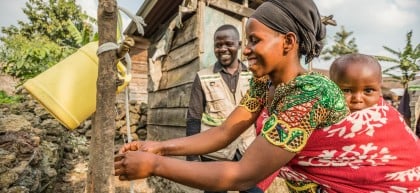
Knowledge Hub
The Democratic Republic of the Congo crisis, explained: Five things to know in 2025
For decades, one of the world’s deadliest, longest-running crises has been unfolding in the Democratic Republic of the Congo. Until recently, however, you probably haven’t heard much about it.
The setting for one of the worst-ever civil wars in African history, the DRC has shifted from national conflict in the late 1990s to a series of localised, region-specific conflicts over land, resources, and power. With over 7 million internally displaced people (IDP) currently seeking shelter in informal sites or with host communities, the DRC accounts for almost 10% of the global population of displaced people.
A large amount of this instability is driven by the same materials that likely go into the device you’re reading this on, and, ultimately, that same instability has led to one of the world’s worst humanitarian crises.
Here are five things you need to know about the Democratic Republic of the Congo’s crisis in 2025.

1. A legacy of crisis and conflict has led to a breaking point
The DRC has endured decades of multiple, overlapping crises, the roots of which stretch back into the Atlantic slave trade and a 75-year reign of terror led by King Leopold II of Belgium.
The effects of colonialism are still felt in the country, which has been caught in a cycle of political instability since gaining independence in 1960 (thanks in no small part to a dictatorship backed by Belgium and the United States). The 36-year reign of dictator Mobutu Sese Seko ended when he was deposed during the First Congo War, which lasted a little over six months between 1996 and 1997. Mobutu’s successor, Laurent-Désiré Kabila, was assassinated during the Second Congo War, which stretched from 1998 to 2003. The inauguration of President Félix Tshisekedi — who took over from Kabila’s son, Joseph, in 2019 — marked the first peaceful transfer of power in nearly 60 years.

However, that peaceful transfer does not equal peace writ large. Since the end of the Second Congo War, regional violence between rebel groups and government forces have uprooted millions of Congolese. In 2016, such clashes led to a full-scale conflict in the Kasaï province, one that displaced more than 1.4 million people. In March 2022, violence escalated in the eastern provinces (particularly North and South Kivu). This continued in 2023, along with renewed fighting in western provinces, bringing an already-complicated humanitarian crisis to a breaking point.
Despite an inter-agency scale-up in humanitarian response, conditions and since January 2025, over 400,000 people have fled to the city of Goma to escape the escalation in the conflict.
“This is not business as usual in the DRC,” Antoine Sagot-Priez, Country Director for Concern DRC, said in March. “We need people to know what is happening here.”
Unfortunately, conditions have continued to worsen and in January 2025, intensified fighting took place between the Congolese army (FARDC) and rebel group M23, leading to the M23 taking control over large swathes of North and South Kivu, including the major cities of Goma and Bukavu and the town of Masisi.
2. Over 7 million Congolese have been displaced
The UN estimates that up to 1 million people have been re-displaced in Goma since the beginning of 2025 bringing the total to around 7.3 million displaced people across the country. Hundreds of thousands more people have been displaced in other parts of North Kivu and in South Kivu.
More than 80% of these displacements are the result of armed attacks and clashes, and the overwhelming majority were displaced in North and South Kivu (both of which have faced waves of harsh violence over the last fifteen years).
This latest round of forced migration represents roughly 10% of the total displacement figures for the country: The Democratic Republic of Congo represents Africa’s largest internal-displacement crisis (and the the world’s third-largest overall), with 7.3 million internally-displaced persons (IDPs) as of January, 2025. The DRC is also one of the world’s largest refugee crises, with approximately 1 million Congolese seeking asylum abroad (primarily in Uganda, Burundi, Rwanda, Zambia, and Tanzania).
It’s worth noting that the DRC is also a major host country for refugees from other countries — particularly for the neighbouring Central African Republic, Rwanda, South Sudan, and Burundi — with over 520,000 refugees recorded in the country in 2024. These refugees find themselves in an especially difficult situation, escaping conflict in one country to find asylum in a neighbouring country that also poses risks to civilian safety. Conditions in displacement camps (both for internally-displaced Congolese and refugees/asylum seekers from neighbouring countries) are often challenging at best, with key concerns including overall safety, gender-based violence, climate risks, disability inclusion, and adequate housing.
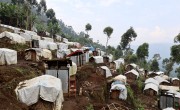
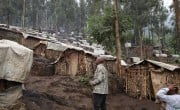
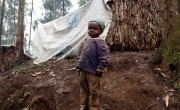

3. Over 21.2 million Congolese require humanitarian assistance
Even for those who haven’t been forced to leave their homes due to ongoing violence, the DRC represents one of the worst ongoing humanitarian crises. At the beginning of 2024, the UN’s Office for the Coordination of Humanitarian Affairs (OCHA) estimated that 21.2 million people in the country (roughly 20% of its population) require some form of humanitarian assistance. That includes 13.7 million children.
Right now, the biggest need in the country is centred on food security (more on that below), with 100% of those requiring humanitarian assistance requiring aid in this area with 25.6 million people facing acute food insecurity, including 6.2 million in the eastern provinces of Ituri and North Kivu. Tragically, across the country 4.5 million children under 5 require nutrition treatment.
Health and nutrition is another key area of need, with many people struggling to access healthcare due to the conflict, lack of resources and the remoteness of some communities. Illnesses such as cholera, measles, malaria, mpox and chronic malnutrition are being spread within and exasperated by the poor conditions in camps and surrounding communities and broader infrastructure (water, sanitation, schools, and homes) are being destroyed by the recent fighting.

4. The DRC is also home to one of the world’s biggest hunger crises
Among the many “worst” lists that the DRC currently sits on is another major issue: hunger. According to the Integrated Food Security Phase Classification (the agency that measures hunger rates and famine risk), over 25 million Congolese are at a crisis level of hunger or higher (with nearly 3 million just one step below the official classification of famine).
Most of this hunger comes down to conflict. Fighting has deprived families of their livelihoods which, for the vast majority of Congolese, lie in agriculture. This means that millions of people are unable to grow the food that they use for both sustenance and their income. In some of these conflict zones, humanitarian access is also limited, meaning that it’s harder to get aid in for civilians.




Parts of the country enjoying relative peace, however, are also struggling. A recent example of this is Tanganyika province, which over the last few years has stabilised following heavy conflict: “It’s in that phase of, ‘Okay, the conflict has stopped for large parts of this province, but there’s no food, there’s no investment, there’s nothing,’” one former Concern DRC staff member explained in 2021. “It was all destroyed, or it’s all gone.” This is one part of the cycle of conflict that’s easily forgotten: Any stability that comes with peace can be short-lived if resources remain scarce.
The DRC also faces a volatile economy, which hits food prices. At the end of 2023, the Congolese franc’s inflation rate stood at 23%, over two percentage points above the target of 20.8%. With nearly 75% of the country living below the international poverty line, these fluctuations have dire consequences. 2025 continues to see the soaring prices of staple foods, including beans, corn flour, vegetable oil and rice. Despite the DRC boasting fertile lands and abundant water resources, the country has been held back from becoming self-sufficient in food production due to a combination of the impact of climate change, epidemics, lack of investment and conflict.
5. The DRC is the sixth-lowest country on the UN’s Human Development Index — but it doesn’t have to be like this
Democratic Republic of the Congo consistently ranks among the world’s “poorest” countries, with (as noted above) 75% of the population living below the poverty line. However, it also has one of the largest reserves of potential wealth, including 200 million acres of cultivable land and large reserves of gold, diamonds, copper, zinc, coltan, and cobalt.
If you’ve heard anything about the DRC’s crisis in the last few months, those last two resources may sound familiar: Coltan is the source of tantalum, which is a mineral essential to the manufacture of smartphones (and, to a lesser extent, computers). Both tantalum and cobalt are used to keep rechargeable batteries powered. By extension, the DRC powers our phones, producing 67% of the world’s coltan and over 70% of the world’s cobalt.
Despite this being a lucrative industry, the hundreds of thousands of Congolese — many of whom are children — working in these mines are not seeing adequate compensation for their work. Many aren’t paid at all. This is the legacy of colonialism in action in the DRC today, with corporations and private interests taking over for monarchies. This continues to be a key driver of violence and instability within the country as well. Apple has announced that, by 2025, it will rely only on recycled cobalt from older models of its products, which is a step in the right direction. However, it will take more than one company to change these labour practices — and it’s essential that this does happen in order to ensure a lasting stability and peace in the country.
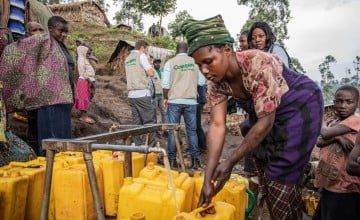
Concern in Democratic Republic of the Congo
2025 marks Concern’s 31st anniversary of working in Democratic Republic of the Congo. Part of our work has been to address the country’s decades-long humanitarian crisis, particularly in the east.
As a member of the Rapid Response Mechanism (SAFER consortium), Concern responds to displacement in the DRC by providing emergency relief to those who need it most. Other programmes allow Concern to respond to including nutrition-related emergencies, food security shocks, and protracted needs in the sectors of WASH and shelter.
Last year, Concern supported over 100,000 individuals displaced by conflict and natural disasters in DRC with emergency cash transfers/vouchers and food distributions. We were also awarded a generous grant from the UK’s Foreign Commonwealth and Development Office to fund essential nutrition, protection, livelihoods and inclusion programmes in cooperation with three international partners and one national NGO. By pooling the sectoral and geographical knowledge of a wide range of organisations, Concern and partners aim to reach over 400,000 vulnerable Congolese with life-saving support that will have genuine, lasting impact.
